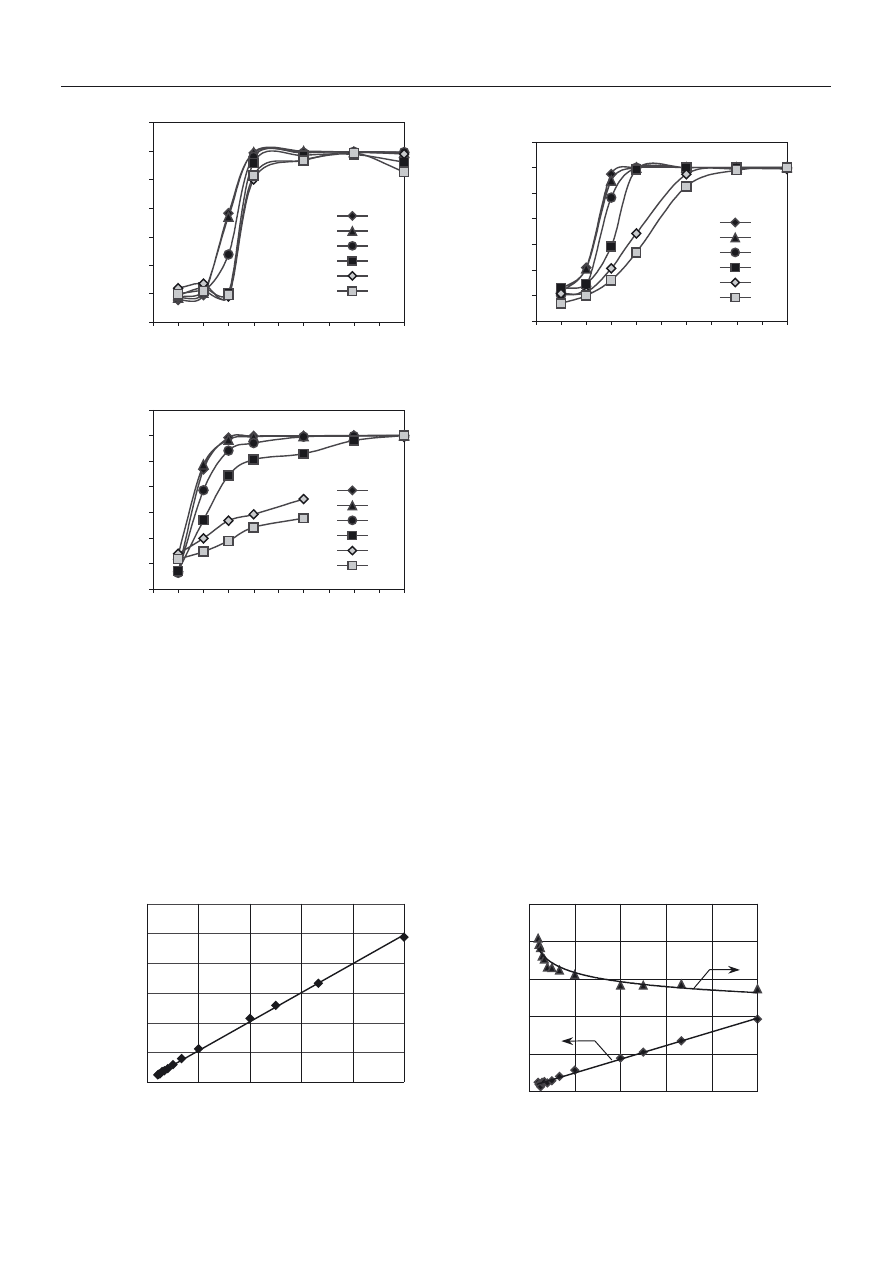
IRENA KORUS
Silesian University of Technology
Institute of Water and Wastewater Engineering
ul. Konarskiego 18, 44-100 Gliwice, Poland
e-mail: irena.korus@polsl.pl
Removal of Pb(II) ions by means of polyelectrolyte enhanced
ultrafiltration
Summary — This work proposes polyelectrolyte enhanced ultrafiltration to remove Pb(II) from aque-
ous solutions. Model solutions containing 1—100 mg Pb/dm
3
were used in the research. Poly(sodium
4-styrenesulfonate) (PSSS), which is a water-soluble polymer containing strong cation-exchange
groups, was used as a metal binding agent. The process was conducted on a polysulfone membrane
with molecular weight cut-off 60 000. The main parameters determining the effectiveness of lead
retention (the polyelectrolyte quantity and solution pH) were examined. High retention coefficients
(>0.98) were achieved for pH > 4 and 2.5—5-fold excess of polyelectrolyte to metal. Ultrafiltration
concentration of Pb(II) solution (50 mg/dm
3
) was carried out according to the previously determined
polymer/metal concentration ratio, and at optimum pH. The lead retention coefficient (R), observed
during the process, was within the range of 0.98—0.99. The retentate obtained was used in the next
decomplexation-ultrafiltration step (ultrafiltration at pH = 1), which made possible the separation of
polyelectrolyte (retentate) and the recovery of 85
% of concentrated Pb ions (permeate). The residual
lead, still remaining in the polymer solution, was diafiltred by a 5-fold amount of water acidified to
pH = 1.
Key words: lead(II), polyelectrolyte, ultrafiltration, polysulfone membrane.
USUWANIE JONÓW Pb(II) W PROCESIE ULTRAFILTRACJI WSPOMAGANEJ DZIA£ANIEM
POLIELEKTROLITU
Streszczenie — W pracy zaproponowano ultrafiltracjê wspomagan¹ dzia³aniem polielektrolitu jako
metodê usuwania jonów Pb(II) z roztworów wodnych. Badania prowadzono na modelowych roztwo-
rach zawieraj¹cych 1—100 mg Pb/dm
3
. Polielektrolitem u¿ytym do wi¹zania jonów o³owiu by³ poli(4-
-styrenosulfonian sodu) (PSSS), rozpuszczalny w wodzie polimer anionowy, zawieraj¹cy grupy o
silnych w³aœciwoœciach kationowymiennych. W ultrafiltracji wykorzystano membranê polisulfonow¹
Sepa® CF EW (Osmonics) o rozdzielczoœci granicznej 60 000. Badania wstêpne prowadzono stosuj¹c
roztwory zawieraj¹ce 1, 10 lub 100 mg Pb/dm
3
, zmieniaj¹c stosunek molowy polimer/metal w zakre-
sie 0,5—10 oraz pH w zakresie 1—10. Na podstawie wyznaczonych wartoœci wspó³czynnika retencji
metalu (R) (rys. 1) stwierdzono wysok¹ efektywnoœæ procesu rozdzia³u (R > 0,98) w warunkach pH > 4
i przy stosunku molowym polimer/metal wynosz¹cym 2,5 (1 i 10 mg Pb/dm
3
) lub 5 (100 mg
Pb/dm
3
). Kolejny etap badañ obejmowa³ ultrafiltracyjne zatê¿anie roztworu o stê¿eniu 50 mg
Pb/dm
3
. Proces prowadzono z zachowaniem 5-krotnego nadmiaru polimeru w stosunku do metalu,
przy pH = 6, stosuj¹c ciœnienie 0,1 MPa. W trakcie procesu, którego postêp wyra¿ono za pomoc¹
wspó³czynnika redukcji objêtoœci (VRF), analizowano wartoœci stê¿eñ metalu w retentacie (rys. 2a)
i permeacie (rys. 2b) oraz okreœlano strumieñ permeatu (rys. 2b), mierz¹c objêtoœæ permeatu uzyskan¹
w jednostce czasu z jednostkowej powierzchni membrany. Uzyskano wysok¹ efektywnoœæ procesu.
Wyodrêbniony retentat, o stê¿eniu Pb ok. 20-krotnie wy¿szym od stê¿enia roztworu wyjœciowego,
poddany zosta³ procesowi dekompleksowania i diafiltracji. Proces dekompleksowania-ultrafiltracji,
polegaj¹cy na rozbiciu po³¹czeñ polimer-metal i separacji zatê¿onego metalu, pozwoli³ na odzyskanie
ok. 85
% metalu (punkt V
H2O
/V
F
= 0 na rys. 3), natomiast diafiltracja prowadzona 5-krotn¹ objêtoœci¹
wody umo¿liwi³a 15-krotne obni¿enie stê¿enia metalu pozosta³ego w retentacie, dziêki czemu mo¿li-
we staje siê odzyskanie i ponowne wykorzystanie zawartego w nim polielektrolitu.
S³owa kluczowe: o³ów(II), polielektrolit, ultrafiltracja, membrana polisulfonowa.
Over the last few years, there have been literature
reports revealing that ultrafiltration enhanced with
water soluble polymers had been successfully applied to
the separation of metal ions from aqueous solutions
POLIMERY 2010, 55, nr 2
135

[1—6]. The group of complexing polymers which form
coordinate covalent bonds, and polyelectrolytes that
have ion-exchange properties can be distinguished.
Typical polymers that bind metal ions include high-mo-
lecular amines, amides, carboxylic acids, amino acids,
alcohols and imines. Majority of the papers deal with the
application of poly(acrylic acid) [1], poly(vinyl alcohol)
[2], chitozane [3, 4] and polyethyleneimine [2—5].
The previous studies of the author, dealing with these
problems, were based on two binding polymers:
poly(acrylic acid) or its sodium salt showing weak cat-
ion-exchange properties and polyethyleneimine, dis-
playing chelating properties towards metals. The proved
suitability of those polymers for the ultrafiltration re-
moval of metals such as Ni, Zn, Cu, Cd, and Pb [6, 7]
acted as an encouragement to extend the research on
polyelectrolytes with strong cation-exchange groups in
the macromolecular structures. Herein, poly(sodium
4-styrene sulfonate) was used as the agent which binds
Pb(II) ions thus making possible their removal during
the ultrafiltration.
EXPERIMENTAL
Materials
Lead(II) nitrate(V) [Pb(NO
3
)
2
] was purchased from
POCh S.A. (Gliwice). As a polyelectrolyte poly(sodium
4-styrene sulfonate) (PSSS), from Aldrich, characterized
by molecular weight M
w
= 70 000 was used.
Method of investigation
The solutions used had a concentration of 1—100 mg
Pb/dm
3
. Metal ions were bound with PSSS and pH was
adjusted using 1 mol/dm
3
NaOH or HNO
3
solutions.
Ultrafiltration was carried out in an AMICON 8400
membrane cell, membrane area of 37.5 cm
2
, equipped
with an additional tank which increased the volume of
the system up to 1200 cm
3
. A Sepa® CF EW (Osmonics)
polysulfone membrane with molecular weight cut-off
(MWCO) 60 000 and distilled water permeability of
1.98 •10
-10
m
3
/(m
2
•s •Pa) was used in the separation
process. Ultrafiltration of the model solutions containing
1, 10 or 100 mg Pb/dm
3
with PSSS as a lead binding
agent was carried out. The results were analyzed assess-
ing the effect of pH and the amount of polyelectrolyte
added on lead retention coefficient (R). pH was adjusted
in a range of 1—10, while the polymer/metal concentra-
tion ratio (mol of mer unit/mol of Pb) in a range of
0.5—10. The analysis of lead concentration, making pos-
sible the determination of R coefficients, was made using
a SpektrAA 880 (Varian) atomic absorption spectrome-
ter. The coefficient R was calculated as follows:
R = 1 – C
P
/C
F
(1)
where: C
P
— concentration of Pb(II) ions in the permeate,
C
F
— concentration of Pb(II) ions in the feed solution.
pH values and polymer/metal molar ratios selected
after the initial tests were used to concentrate a solution
containing 50 mg Pb/dm
3
. The process was carried out
until volume reduction factor (VRF defined as the ratio
of the initial feed volume and the volume remaining in
the retentate) of 25 was achieved. Ultrafiltration was
conducted at 0.1 MPa, recording permeate flux values
and analyzing periodically the concentrations of Pb(II)
in the retentate and permeate (SpectrAA 880 Varian).
The retentate produced during the concentration
process was subjected to decomplexation-ultrafiltration
process, carried out under conditions which secured the
breaking of the bonds between lead and polyelectrolyte
(pH = 1) and separation of the metal and polymer. The
concentrations of lead in the retentate and permeate
were analyzed during that process. Then, the retentate
that contained concentrated polyelectrolyte along with
remaining lead was subjected to diafiltration by continu-
ously passing a five-fold amount of deionized water
acidified to pH = 1. The efficiency of lead leaching was
evaluated by analysis of Pb(II) concentration in the re-
tentate during diafiltration.
RESULTS AND DISCUSSION
Effect of polymer amount and pH of the solution
on the effectiveness of lead separation
PSSS is a water-soluble polyelectrolyte containing
sulfonic groups and hence its cation-exchange proper-
ties. Its ability to bind metal ions is largely dependent
upon pH of the solution, due to protonation of sulfonic
groups under acidic conditions. The effect of pH and the
polymer/metal molar ratio on the effectiveness of lead
separation from 1, 10 and 100 mg/dm
3
solutions are
given in Figure 1. pH is a significant parameter which
affects the effectiveness of lead separation. This is
proved by the wide distribution of retention coefficients
found. Low retention coefficients, indicating the lack of
lead binding with the polyelectrolyte, were found at pH
range of 1—2. An increase in pH up to
≥ 4 produced high
effectiveness of the separation process.
In the solutions of low concentration (1 mg Pb/dm
3
),
an effective lead retention took place at even equimolar
polymer/metal ratio. Higher concentrations of lead (100
mg Pb/dm
3
) needed larger amounts of polyelectrolyte,
exceeding 5-fold the molar amount of lead in the solu-
tion.
Ultrafiltration of Pb(II) solution
The concentration process was carried out at 5-fold
excess of polyelectrolyte to lead ions and pH = 5.9—6.1.
Figure 2 depicts the changes in lead concentration in
the retentate, permeate and permeate flux observed dur-
ing the ultrafiltration concentration of 50 mg Pb/dm
3
solution. The course of the process was expressed by
136
POLIMERY 2010, 55, nr 2

VRF factor. The data indicate high effectiveness of the
suggested method of lead removal from aqueous solu-
tions, proved by lead R coefficient values, within the
range 0.98 — > 0.99.
The separation process resulted in the retentate with
about 20 times higher lead concentration in relation to
feed solution and the permeate (96
% of the initial solu-
tion volume) in which averaged Pb(II) concentration
was a mere 0.41 mg/dm
3
. A 30
% decrease in the perme-
ate flux was observed during the process, which can be
explained by the gradual increase in lead and polyelec-
trolyte concentrations in the retentate. The biggest
changes were found at the initial stage of the process,
until VRF of 5 was reached.
Figure 3 shows an attempt to recover the concen-
trated metal from the final retentate, employing decom-
plexation-ultrafiltration at pH = 1 (point V
H2O
/V
F
= 0 in
the graph) and the following diafiltration with a 5-fold
amount of water acidified to pH = 1.
Having broken the polymer-metal bonds in acidic
conditions it was possible to recover 85
% of lead present
in the retentate (point V
H2O
/V
F
= 0). The subsequent
-0.2
0.0
0.2
0.4
0.6
0.8
1.0
1.2
0
1
2
3
4
5
6
7
8
9
10
pH
R
10
7,5
5
2,5
1
0,5
PSSS / Pb
a)
b)
-0.2
0.0
0.2
0.4
0.6
0.8
1.0
1.2
0
1
2
3
4
5
6
7
8
9
10
pH
R
10
7,5
5
2,5
1
0,5
PSSS / Pb
c)
-0.2
0.0
0.2
0.4
0.6
0.8
1.0
1.2
0
1
2
3
4
5
6
7
8
9
10
pH
R
10
7,5
5
2,5
1
0,5
PSSS / Pb
Fig. 1. Lead retention coefficient (R) as a function of solution
pH for different polymer/metal molar ratios (PSSS/Pb =
0.5—10) and for concentration of Pb(II) ions equal to: a) 1
mg/dm
3
, b) 10 mg/dm
3
, c) 100 mg/dm
3
0
200
400
600
800
1000
1200
0
5
10
15
20
25
VRF
c
Pb
,
m
g/dm
3
a)
b)
0.0
0.5
1.0
1.5
2.0
2.5
0
5
10
15
20
25
VRF
c
Pb
,
m
g/dm
3
0
15
30
45
60
75
J
v
,d
m
3
/(m
2
h)
Fig. 2. Effect of volume reduction factor (VRF) on lead concentration (C
Pb
) in: a) retentate, b) permeate and permeate flux (J
v
) for
feed solution of 50 mg Pb/dm
3
POLIMERY 2010, 55, nr 2
137

diafiltration step made possible a 15-fold decrease in
lead concentration in the retentate. The data indicate an
efficient leaching of lead that remained in the concen-
trated polyelectrolyte.
CONCLUSIONS
The results herein confirmed the possibility of using a
polyelectrolyte with strong cation-exchange properties
to aid ultrafiltration removal of Pb(II) ions from aqueous
solutions. Both pH and the polymer/metal molar ratio
had a decisive influence on the effectiveness of such
separation process.
The combination of two ultrafiltration processes car-
ried out under suitable pH conditions led to a consider-
able decrease in Pb(II) concentration in the filtered solu-
tion and a separation of the concentrated stream contain-
ing Pb(II) ions. Furthermore, the application of diafiltra-
tion made it possible to use the polymer again by leach-
ing lead that remained in it.
The study was conducted as a research project financed by
2007—2009 scientific financial resources.
REFERENCES
1.
Cañizares P., Pérez A., Camarillo R., Linares J. J.:
J. Membr. Sci. 2004, 240, 197.
2.
Tavares C. R., Vieira M., Petrus J. C. C., Bortoletto E.
C., Ceravollo F.: Desalination 2002, 144, 261.
3.
Juang R. S., Chiou C. H.: J. Membr. Sci. 2000, 177, 207.
4.
Aroua M. K., Zuki F. M., Sulaiman N. M.: J. Hazard.
Mater. 2007, 147, 752.
5.
Molinari R., Gallo S., Argurio P.: Water Research 2004,
38, 593.
6.
Bodzek M., Korus I., Loska K.: Desalination 1999, 121,
117.
7.
Korus I., Loska K.: “Removal of lead(II) ions in com-
plexation ultrafiltration process”, in: “Monografie
Komitetu In¿ynierii Œrodowiska PAN”, vol. 22, Lub-
lin 2004, pp. 511—521 (in polish).
Received 2 II 2009.
0
200
400
600
800
1000
1200
0
1
2
3
4
5
V
H2O
/
V
F
c
Pb
,m
g
/d
m
3
retentate
permeate
Fig. 3. Concentrations of lead C
Pb
in retentate and permeate
observed during decomplexation-ultrafiltration (point
V
H2O
/V
F
= 0) and diafiltration, at different volume ratios of
diafiltered water and feed solution (V
H2O
/V
F
)
138
POLIMERY 2010, 55, nr 2
Wyszukiwarka
Podobne podstrony:
FP w 08
08 Elektrownie jądrowe obiegi
archkomp 08
02a URAZY CZASZKOWO MÓZGOWE OGÓLNIE 2008 11 08
ankieta 07 08
08 Kości cz Iid 7262 ppt
08 Stany nieustalone w obwodach RLCid 7512 ppt
2009 04 08 POZ 06id 26791 ppt
08 BIOCHEMIA mechanizmy adaptac mikroor ANG 2id 7389 ppt
depresja 08 09
W15 08 II
Szkol Ogólne 08 1pomoc
08 NIEDZIELA ZWYKŁA B
08 md wykl8
WM1 08 Rozkład naprężeń
Białka 08 06 05
więcej podobnych podstron